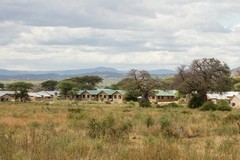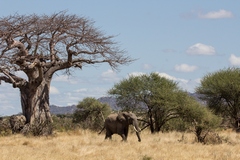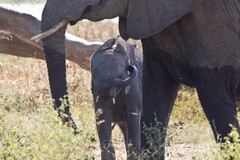Credits: By Don Pinnock - April 2016 in SA Breaking News Conservation Action Trust
Photos by Nature-Explored

The Rangers village at Msembe airstrip in
Ruaha National Park. Rangers lay their lives
on the line every day to protect the wildlife and
they all should all be treated like heroes.
Their families have to live with the constant
threat to their husbands from poachers
A multipronged Tanzanian project has reduced elephant poaching numbers by two thirds within six years. It’s a model for all Africa.
When elephant poachers enter a protected area they’re armed, alert and dangerous. Back home they’re relaxed and vulnerable. That’s where an organization in Ruvuma, Southern Tanzania, hits them hardest.
Until recently massive poaching was taking place in the wildlife corridor connecting the Selous Game Reserve in Tanzania and Niassa National Park in Mozambique. It’s an area where wildlife roams between two unfenced game reserves and is highly vulnerable.
Faced with a crashing elephant population, the Ruvuma Elephant Project (REP) rethought conventional strategies which were clearly failing. It has since notched up remarkable successes, which are a useful pointer for South Africa which has similar problems with rhinos.
Across Africa the scale of the ivory poaching is immense, with an estimated 30 000 to 35 000 African elephants being illegally killed annually. Tanzania has lost by far the most, its elephant population having declined by about 66 000 in six years up until November 2014.
In 2009 the national population was estimated at 109 000 – by 2014 it was down to 43 000. This equates to one elephant being killed every 45 minutes in Tanzania alone. Some of the biggest declines have been in areas with the largest donor-funded projects – a real problem for future funding.

This is a young bull elephant in Ruaha
National Park. As he starts to grow reasonable
ivory he becomes a prime target. There are
very few older bulls left
Wayne Lotter of Protected Area Management Solutions (PAMS Foundation), of which REP is a project, says the problem needed a different way to think solutions.
‘We’re built on the premise that a well informed and fully integrated multi-agency approach is the only sensible way to wage a war and expect to be able to win it.’ he insists.
‘Poachers spend 80% of their time, not in the parks doing the poaching, but in their communities. They talk among their friends and that’s where we focus on catching them.
‘Rangers are the last stand against poaching. They represent the equivalent of the Home Guard in a war context. But if we’re to win this war, the front line need not be in the bush where they’re engaged.
‘You must have people infiltrating those areas, plain clothed, working undercover, just mingling, going to pubs, making friends and talking. You pick up leads there. We make 80% of our arrests outside of the bush.’
REP also partners with Tanzania’s National Task Force which leads intelligence-led operations targeting buyers and high level traders in urban areas. And this is followed by thorough with professional case preparation and prosecution.
The strategy is paying off. In comparison to the preceding six years, by the end of 2015 elephant decline in Tanzania was reduced by two thirds. During that year over 1 000 poachers were arrested (many in Dar Es Salaam and other cities), the top three ivory traders were put behind bars, 288 suspects were prosecuted (45 receiving prison sentences of 16 years or longer) and 46 firearms and 40 vehicles transporting ivory were seized.
REP works to build good relationships with communities, fostering relationships between them and protected area authorities. As trust grows, so do detection levels.
It’s not often that local people are happy with national parks as neighbours, says Lotter. ‘You have elephants and other herbivores that graze your crops. You’ve got leopards and lions that kill your goats and your cattle.
Villagers get killed by elephants. At night there are encounters with hippos. Locals are not

Whole families of elephants are slaughtered.
Even ones as small as this are killed for
the tiny amount of ivory they possess. Very
young ones are just left to die
getting any benefit from the wildlife.’
So REP built trust by seeking solutions. Elephants don’t like hot chilli and fear bees, so the project helped locals grow chillies which are smeared on sisal ropes surrounding crops. And it provided bee hives which, when placed every 15 metres, form an anti-elephant barrier. An added advantage is that chilli is now a cash crop and there’s honey available for use or sale.
Since 2011 when REP began, over 200 game scouts have been trained in basic anti-poaching skills and case preparation and are paid for doing patrols. ‘It’s an income that’s better than local employment opportunities,’ says Lotter. ‘It isn’t really big bucks but it’s sustainable money.’
The Ruvuma successes are an object lesson in the need to root out the causes rather than focussing on the symptoms. Given the decimation of rhinos in the Kruger Park and elsewhere, it’s a way of operating South Africa needs to integrate into its anti-poaching strategy, and fast.
Follow the link to the PAMS foundation to learn more and possibly to help